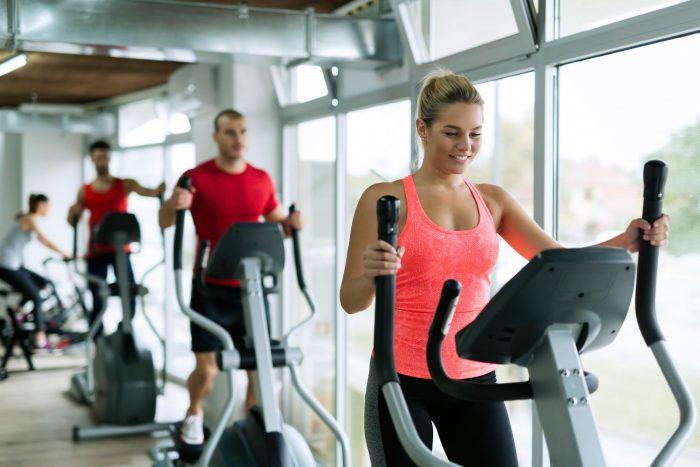Elliptical vs. Treadmill: Which is Better for you?
Ellipticals and treadmills are two of the most popular machines for cardio exercise, but each one has a unique set of pros and cons that can help you decide which one is the better fit. In fact, there’s no one answer as to which is better when it comes to ellipticals versus treadmills. Whether you should be using an elliptical, a treadmill, or both is entirely dependent upon your level of fitness and your goals. Because both machines work your body differently, it’s important to understand the benefits and potential drawbacks of each one.
Benefits of Ellipticals
Ellipticals are still a relatively new machine when compared to treadmills. Though they’ve undergone some upgrades over the years, they only hit the market in the 1990s.
While treadmills set the pace with a revolving belt platform, ellipticals are powered primarily by the user’s body, which provides a different kind of workout.
Other than the actual mechanics, what sets the elliptical apart from the treadmill is the fact that it’s a no-impact activity. This means that your body stays mostly grounded on a platform during exercise.
Low- or no-impact exercises reduce the amount of stress on your body and can prevent wear and tear on your joints. This is an important factor when considering which machine is right for you, especially if you are older or recovering from an injury.
While ellipticals predominantly work your lower body, they offer the ability to cross-train your upper body with built-in pole handles. These handles move your arms back and forth in rhythm with your stride, targeting muscles in your arms, chest, and back.
You can also reverse your stride more easily on an elliptical than on a treadmill. Reverse strides allow you to target different muscles in your legs and provide a more well-rounded strength training workout during your cardio session.
Perhaps most encouraging of all, the perceived exertion on an elliptical is lower, meaning that you are actually doing more work than you think you are. If that’s not an inspiration for working out, we don’t know what is!
Drawbacks of Ellipticals
The downside of lowered perceived exertion is that you might actually be exerting yourself less than you think. That’s because using an elliptical, especially on lower resistance settings, provides a certain amount of momentum.
If you’re not consciously and actively engaging your muscles through each stride, you might cheat by using that momentum to carry you through the motion, reducing the effectiveness of your exercise.
There’s also less flexibility to customize your workout compared to treadmills. While most elliptical machines allow you to change the resistance, many don’t have a feature for changing the incline, which can increase the intensity of the workout.
Some elliptical machines do have incline options, but most aren’t as effective as what you get on a treadmill. There is the option to create an incline yourself by shifting back on the machine, but this can put a strain on your back and arms.
Also, while it’s great that an elliptical is no-impact, the drawback is that it’s not a weight-bearing exercise because you are suspended on pedals that keep your feet stationary. This means that the machine is predominantly carrying your weight while you exercise on it.
Weight-bearing exercises are important because they promote bone and muscle health and can help prevent osteoporosis later in life.
Benefits of Treadmills

While ellipticals can be easier on your joints, they don’t place your body in a natural posture. On the other hand, treadmills don’t restrict your position and support natural movements that mirror running in an outdoor setting.
Due to the impact of treadmill exercises and the fact that you are fully moving your body weight when you do them, they can be considered weight-bearing exercises. You’ll reap the benefits of this perk, whether you’re running or walking at a higher intensity.
Treadmills also typically burn more calories when compared to elliptical exercises completed in the same time period. This can be an attractive benefit if you’re exercising for weight loss. The reason treadmills burn more calories is because the exercises are weight-bearing and typically higher intensity.
Treadmills also typically allow you to change the incline, which increases the intensity and the amount of resistance for your leg muscles.
Drawbacks of Treadmills
As previously stated, treadmills are harder on your joints due to increased impact. While treadmills are better than running outdoors on asphalt, they’re still harder on the body than ellipticals. For this reason, treadmills may not be the ideal workout for people recovering from injuries or for older people.
It’s true: Running on a treadmill hands-free promotes natural movement. But if you want to take advantage of the pulse reader on the handlebars, you’ll have to position yourself in an unnatural posture, which can increase the likelihood of injury.
The size of the belt can also have a negative impact on your posture. Sometimes people will compensate for the length or width of the belt by changing their stride. This can cause undue strain on the body and result in injury.
While treadmills typically burn more calories than an elliptical, this benefit can come at a cost. Due to the increased intensity, treadmills can cause health issues when used in excess. This is especially true of incline exercises, which should be modified for gradual progress.
Ellipticals vs. Treadmills: the Verdict
When it comes to ellipticals, these machines are best used for full-body workouts because of their ability to engage your arms and core in addition to your legs. It’s a double whammy with regard to strength and cardio training.
Ellipticals are also typically less expensive than treadmills, making them a more desirable option for home gyms. Depending on the type and brand, they can also be more mobile than treadmills, making them easier to store and move.
As previously stated, ellipticals are also better if you’re revisiting exercise after an injury due to their ease of use and low-impact nature. That also makes them a good option for older individuals or people who are new to working out and want to take things slow.
On the other hand, if you’re more established in your fitness routine, treadmills can be the best option. This is especially true if you are training for a race. Treadmills promote natural posture when not using the handles and also provide a more intense workout for your lower body when compared to ellipticals.
Treadmills also typically offer better software for tracking your progress in regard to time, distance, and pace.
While treadmills burn more calories per hour, there’s no “right choice” for weight loss. Both machines provide great workouts, so it really comes down to which machine works the best for you.
Whether you’re using an elliptical or a treadmill, it’s important to take pride in the fact that you’re working out and striving to be the healthiest version of yourself!
[updated: October 2019]


